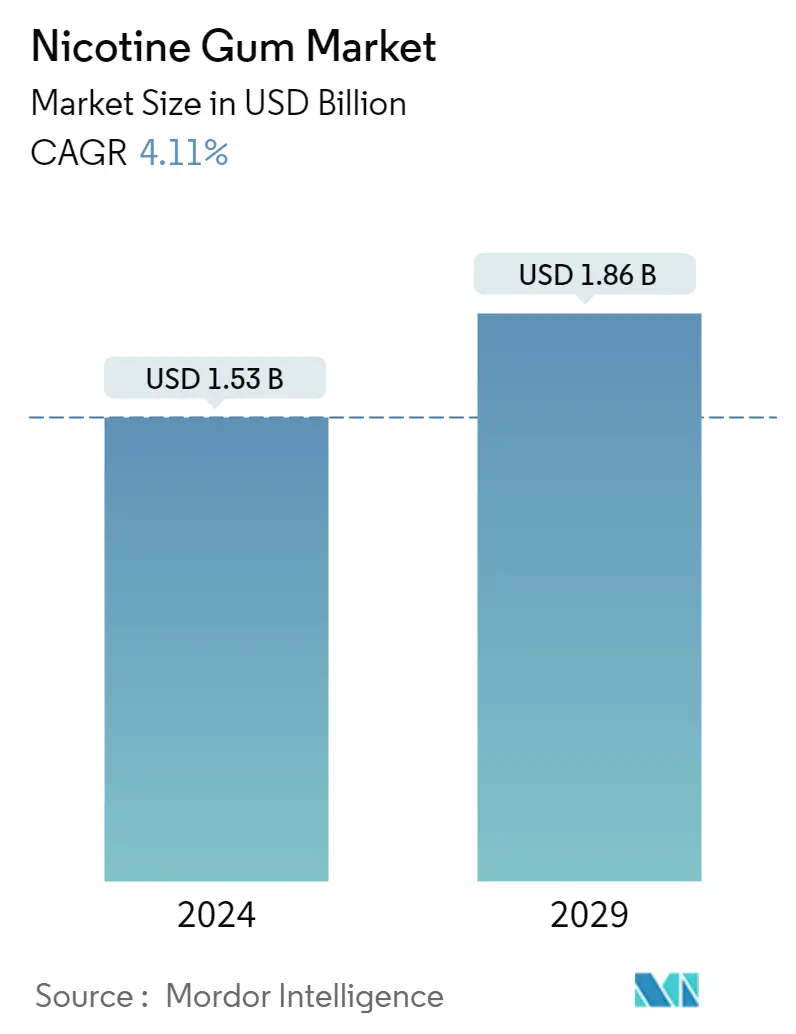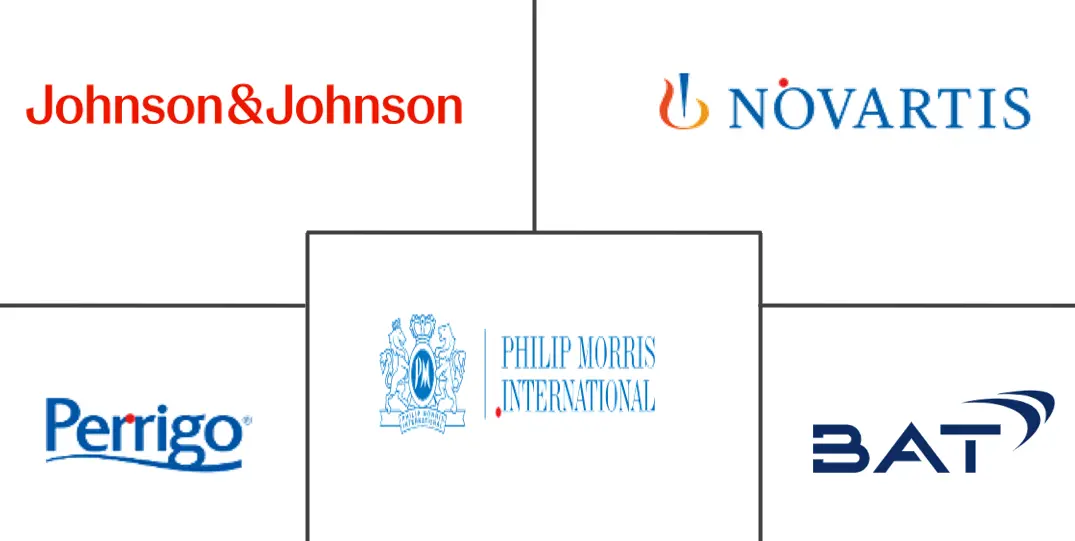Market Size of Nicotine Gum Industry

| Study Period | 2019 - 2029 |
| Market Size (2024) | USD 1.53 Billion |
| Market Size (2029) | USD 1.86 Billion |
| CAGR (2024 - 2029) | 4.11 % |
| Fastest Growing Market | North America |
| Largest Market | Asia Pacific |
Major Players
*Disclaimer: Major Players sorted in no particular order |
Nicotine Gum Market Analysis
The Nicotine Gum Market size is estimated at USD 1.53 billion in 2024, and is expected to reach USD 1.86 billion by 2029, growing at a CAGR of 4.11% during the forecast period (2024-2029).
Nicotine gum, an FDA-approved medication containing nicotine polacrilex as its active ingredient, is utilized to aid individuals in quitting smoking. The market for nicotine gum is influenced by several factors, such as the increasing preference for smoking cessation aids, government efforts to regulate tobacco consumption, and the growing number of smoking-related deaths. For instance, the UK government's goal to achieve a smoke-free status by 2030 has resulted in substantial investments in stop-smoking services and other initiatives designed to assist individuals in quitting smoking.
The global demand for nicotine replacement therapy (NRT) products, like nicotine gum, has been on the rise in recent years as more individuals seek ways to quit smoking and minimize their contact with the harmful substances present in tobacco smoke. Current trends in the global NRT market involve the creation of more user-friendly and efficient NRT products, such as extended-release gums, and the increasing preference for flavored choices. Additionally, the significant number of deaths attributed to smoking has driven manufacturers to create new products that minimize tobacco-related harm, thereby propelling market expansion. According to the World Health Organization (WHO), the projected number of tobacco smokers across the African, American, European, and South East Asian regions will be 62 million, 118 million, 168 million, and 418 million, respectively, by 2025. Such factors drive the demand for nicotine gums globally.
Nicotine Gum Industry Segmentation
Nicotine gum is a chewing gum that contains nicotine and is used to help people stop smoking. The Nicotine gum market is segmented by type, distribution channel, and geography. By type, the market is segmented into 2 mg nicotine gum and 4 mg nicotine gum. By distribution channel, the market is segmented into supermarkets/hypermarkets, convenience stores/tobacco stores, online retail stores, and other distribution channels. By geography, the market is segmented into North America, Europe, Asia-Pacific, South America, and Middle East and Africa. For each segment, the market sizing and forecasts have been done on the basis of value (USD).
| Type | |
| 2 mg Nicotine Gum | |
| 4 mg Nicotine Gum |
| Distribution Channels | |
| Supermarkets/Hypermarkets | |
| Convenience Stores/Tobacco Stores | |
| Online Retail Stores | |
| Other Distribution Channels |
| Geography | |||||||||
| |||||||||
| |||||||||
| |||||||||
| |||||||||
|
Nicotine Gum Market Size Summary
The nicotine gum market is experiencing growth driven by increasing consumer preference for smoking cessation aids and supportive government initiatives aimed at reducing tobacco consumption. The market is bolstered by the rising awareness of the health risks associated with smoking, prompting more individuals to seek nicotine replacement therapies (NRT) like gum and patches. The availability of flavored alternatives and longer-lasting gums has further enhanced the appeal of these products, making them a popular choice among smokers looking to quit. Regulatory approvals, such as those from the FDA, have also played a crucial role in legitimizing nicotine gum as an effective medicinal aid for smoking cessation. The market's expansion is supported by efforts from both public and private sectors, including donations of nicotine patches and investments in stop-smoking services, which underscore the global commitment to reducing smoking-related harm.
The competitive landscape of the nicotine gum market is characterized by the presence of numerous global and regional players, each striving to capture a significant share of the market. Companies like British American Tobacco, Haleon Group, Johnson & Johnson, Perrigo Company, and Philip Morris International are actively expanding their product portfolios and innovating to meet the growing demand for nicotine gum. The introduction of unique products, such as sugar-free gums and those with improved flavors and textures, highlights the industry's focus on differentiation and consumer satisfaction. Strategic initiatives, including acquisitions and the development of digital support ecosystems, further illustrate the dynamic nature of the market as companies seek to enhance their offerings and maintain a competitive edge.
Nicotine Gum Market Size - Table of Contents
-
1. MARKET DYNAMICS
-
1.1 Market Drivers
-
1.1.1 Growing Awareness of the Harms of Smoking Driving NRT (Nicotine Replacement Therapy)
-
1.1.2 Innovation in Nicotine Formulations Drive Growth
-
-
1.2 Market Restraints
-
1.2.1 Regulatory Concerns on Nicotine Consumption Restricting Growth
-
-
1.3 Porter's Five Forces Analysis
-
1.3.1 Threat of New Entrants
-
1.3.2 Bargaining Power of Buyers/Consumers
-
1.3.3 Bargaining Power of Suppliers
-
1.3.4 Threat of Substitute Products
-
1.3.5 Intensity of Competitive Rivalry
-
-
-
2. MARKET SEGMENTATION
-
2.1 Type
-
2.1.1 2 mg Nicotine Gum
-
2.1.2 4 mg Nicotine Gum
-
-
2.2 Distribution Channels
-
2.2.1 Supermarkets/Hypermarkets
-
2.2.2 Convenience Stores/Tobacco Stores
-
2.2.3 Online Retail Stores
-
2.2.4 Other Distribution Channels
-
-
2.3 Geography
-
2.3.1 North America
-
2.3.1.1 United States
-
2.3.1.2 Canada
-
2.3.1.3 Mexico
-
2.3.1.4 Rest of North America
-
-
2.3.2 Europe
-
2.3.2.1 Spain
-
2.3.2.2 United Kingdom
-
2.3.2.3 Germany
-
2.3.2.4 France
-
2.3.2.5 Italy
-
2.3.2.6 Russia
-
2.3.2.7 Rest of Europe
-
-
2.3.3 Asia-Pacific
-
2.3.3.1 China
-
2.3.3.2 Japan
-
2.3.3.3 India
-
2.3.3.4 Australia
-
2.3.3.5 Rest of Asia-Pacific
-
-
2.3.4 South America
-
2.3.4.1 Brazil
-
2.3.4.2 Argentina
-
2.3.4.3 Rest of South America
-
-
2.3.5 Middle East and Africa
-
2.3.5.1 South Africa
-
2.3.5.2 United Arab Emirates
-
2.3.5.3 Rest of Middle East and Africa
-
-
-
Nicotine Gum Market Size FAQs
How big is the Nicotine Gum Market?
The Nicotine Gum Market size is expected to reach USD 1.53 billion in 2024 and grow at a CAGR of 4.11% to reach USD 1.86 billion by 2029.
What is the current Nicotine Gum Market size?
In 2024, the Nicotine Gum Market size is expected to reach USD 1.53 billion.

